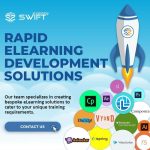The Benefits of Rapid E-learning Development

In today’s fast-paced business world, organizations need to keep up with the latest technology and training trends to remain competitive. One of the most significant trends in recent years has been the rise of e-learning, and specifically, rapid e-learning development. Rapid e-learning development is the process of creating e-learning content quickly and efficiently, using tools and techniques that streamline the process. In this blog post, we’ll explore the benefits of rapid e-learning development and how it can benefit organizations of all sizes.
1. Faster Time-to-Market
One of the most significant benefits of rapid e-learning development is that it can help organizations get their training content to market faster. Traditional e-learning development can take weeks or even months to complete, while rapid e-learning development can be completed in a matter of days or weeks. This speed allows organizations to respond quickly to changing business needs, market trends, or new regulations.
2. Cost-Effective
Rapid e-learning development can also be more cost-effective than traditional e-learning development. Traditional e-learning development often involves a team of instructional designers, graphic designers, and developers, which can be expensive. In contrast, rapid e-learning development can be done by a smaller team or even an individual, reducing costs significantly.
Additionally, rapid e-learning development tools are often less expensive than traditional e-learning development tools, making them accessible to small and medium-sized businesses that may not have the resources to invest in more expensive e-learning development software.
3. Improved Engagement and Retention
Another benefit of rapid e-learning development is that it can improve learner engagement and retention. Rapid e-learning development tools often include interactive features, such as quizzes, games, and simulations, that make the learning experience more engaging and interactive.
In addition, rapid e-learning development allows organizations to update their training content more frequently, which can keep the content fresh and relevant, improving learner engagement and retention.
4. Customizable
Rapid e-learning development tools are often highly customizable, allowing organizations to tailor their training content to their specific needs. This customization can include adding branding elements, incorporating company-specific terminology or processes, or including content that is specific to a particular job function or industry.
Customization can also help organizations to meet the unique needs of their learners, such as incorporating language support for non-native speakers or providing accessibility options for learners with disabilities.
5. Easy to Update and Maintain
Rapid e-learning development tools often include features that make it easy to update and maintain the training content. For example, some tools allow organizations to update their training content in real-time, without the need for a developer or instructional designer. This flexibility allows organizations to respond quickly to changing business needs or new regulations.
In addition, rapid e-learning development tools often include features that make it easy to maintain the training content, such as version control, content management systems, and reporting and analytics tools.
6. Scalable
Finally, rapid e-learning development is highly scalable, allowing organizations to deliver training content to large numbers of learners quickly and efficiently. This scalability can be particularly beneficial for organizations that have a geographically dispersed workforce or need to deliver training content to large numbers of customers or partners.
In conclusion, the benefits of rapid e-learning development are numerous, including faster time-to-market, cost-effectiveness, improved engagement and retention, customization, easy updates and maintenance, and scalability. By using rapid e-learning development tools and techniques, organizations can create training content that is relevant, engaging, and accessible to learners of all types, while remaining competitive in today’s fast-paced business world.
